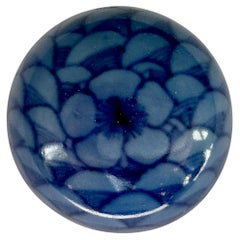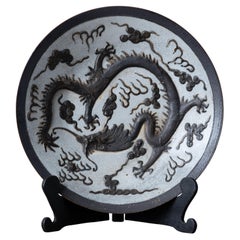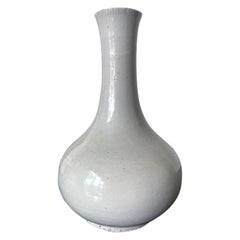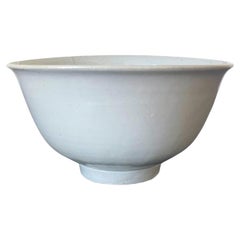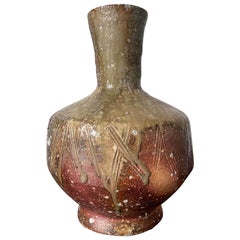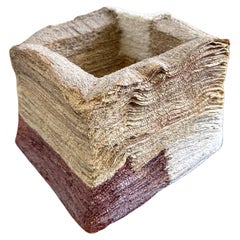Georgia - Ceramics
to
25
316
1,986
1,348
293
23
41
1
1
117
92
84
23
38
12
17
12
2
1
2
2
2
313
73
11
10
7
288
277
125
76
76
316
316
316
27
11
10
3
3
Item Ships From: Georgia
Blue-Glazed Porcelain Box from Hatcher Collection
Located in Atlanta, GA
17th century Chinese porcelain blue-glazed circular pill box from the Hatcher Collection, painted in different tones of blue with a central prunus flower on a wave pattern ground tha...
Category
17th Century Chinese Antique Georgia - Ceramics
Materials
Porcelain
Nanking Crackle Glazed Dragon Charger, 19th Century
Located in Savannah, GA
A Nanking crackle glazed dragon charger, 19th century.
16 inches wide by 3 inches tall
Category
19th Century Antique Georgia - Ceramics
Materials
Porcelain
Large Antique White Glazed Bottle Vase Korean Ceramic Joseon Dynasty
Located in Atlanta, GA
On offer is a Korean ceramic bottle vase circa 19th century made in the late Joseon dynasty (1392-1910). The vase is of a classic bottle form with a bulbous body and a long neck with...
Category
19th Century Korean Other Antique Georgia - Ceramics
Materials
Ceramic
Antique Korean Ceramic White Bowl Joseon Dynasty
Located in Atlanta, GA
A Korean ceramic bowl covered in a white glaze with a hint of bluish green circa 18th century, possibly earlier of the Joseon Dynasty. The deep bowl fea...
Category
18th Century Korean Archaistic Antique Georgia - Ceramics
Materials
Ceramic
Modern Japanese Ceramic Shigaraki Ikebana Vase Takahashi Shunsai
Located in Atlanta, GA
A tall ceramic vase made in the tradition of Shigaraki ware by Japanese potter Takahashi Shunsai (1927-2011), the fourth heir of the famed Rakusai lineage of potters. The vase is heavily potted in the reddish sandy Shigaraki clay. It has a Classic vase form made for Ikebana display. The surface is thickly draped with natural ash glaze that deposited onto the body during the firing process in the kiln. It also features decoration of carved lines. Nuggets of feldspar were incorporated in the clay and exposed onto the surface as crystal like jewels. Substantial and archaic looking, the vase also has a strong modern appeal due to its Mingei styling. It was signed on the base with a pressed seal Shunsai as shown. The vase comes with its original wood storage box (tomobako) with bears the title and signature in Kanji and a seal. It also retains a paperwork noting the artist's biography and practice philosophy in Japanese.
Born in Shigaraki, Shunsai was the second son of renowned potter Takahashi Rakusai...
Category
1990s Japanese Modern Georgia - Ceramics
Materials
Ceramic
Ceramic Sculpture by South Korean Artist Jongiin Park
By Jongjin Park
Located in Atlanta, GA
A highly unique ceramic sculpture by South Korean artist Jongjin Park (1982-). The square-form piece is boundary-pushing and defies both the traditional ...
Category
2010s South Korean Organic Modern Georgia - Ceramics
Materials
Ceramic, Paper
Japanese Ceramic Vase Mingei Style Hamada Shoji
By Hamada Shoji
Located in Atlanta, GA
A heavily potted stoneware vase in cylindrical form, decorated with abstract strokes in iron rust glaze (known as Persimmon Glaze in Japanese) on a black glazed background. The pattern suggests autumn grasses, and it was applied with free hands. The vase is attributed to Japanese potter Hamada Shoji...
Category
Late 20th Century Japanese Arts and Crafts Georgia - Ceramics
Materials
Ceramic
Early 20th Century Meiji Period Japanese Samurai Enamel Decorated Charger
Located in Atlanta, GA
This platter is absolutely massive and stunning. The enamel decoration depicts a pair of samurais and birds. Verso is signed and had extra strength plate hanger...
Category
19th Century Antique Georgia - Ceramics
Materials
Enamel
$1,560 Sale Price
20% Off
Japanese Contemporary Celadon Ceramic Bowl by Ono Kotaro
By Ono Kotaro
Located in Atlanta, GA
A ceramic bowl with celadon glaze by Japanese potter Ono Kotaro (Japanese, b. 1953). Named "Circular Reef", the fine porcelain bowl features an irregular ed...
Category
Late 20th Century Japanese Modern Georgia - Ceramics
Materials
Ceramic
Japanese Ceramic Seto Tea Leaf Tsubo Jar Edo Period
Located in Atlanta, GA
A Japanese glazed ceramic jar with a lacquered wood lid circa 19th century of late Edo to early Meiji Period. The stoneware tsubo was used as a storage vessel for produce such as tea...
Category
19th Century Japanese Edo Antique Georgia - Ceramics
Materials
Ceramic
Large Ceremic Shigaraki Tsubo by Nagaoka Masami
Located in Atlanta, GA
An impressive Shigaraki Tsubo (jar normally for storage) in an archaic form with a bulbous and robust body that opens with a small lipped mouth. Heavil...
Category
21st Century and Contemporary Japanese Modern Georgia - Ceramics
Materials
Ceramic
Large Contemporary Japanese Shigaraki Vessel Kohyama Yasuhisa
By Kohyama Yasuhisa
Located in Atlanta, GA
A striking stoneware vase made in the tradition of Shigaraki ware by celebrated Japanese potter Kohyama Yasuhisa (1936-) in the year of 2005. Born in the town of Shigaraki, Yasuhisa ...
Category
Early 2000s Japanese Modern Georgia - Ceramics
Materials
Ceramic
Japanese Mino Ware Oribe Type Chawan Tea Bowl
Located in Atlanta, GA
A Japanese Kutsu-gata (clog-shaped) chawan (tea bowl) circa 19th century possibly older. The stoneware bowl potted from buff clay has a slight irregular shape and an unusual depth for a tea bowl. Of Mino ware...
Category
19th Century Japanese Meiji Antique Georgia - Ceramics
Materials
Ceramic
Korean Ceramic Celadon Bowl with Slip Inlay Goryeo Dynasty
Located in Atlanta, GA
A good Korean celadon bowl with elaborate slip inlays circa 12-13th century from the Goryeo Dynasties (918 to 1392AD). Despite inspired originally ...
Category
15th Century and Earlier Korean Archaistic Antique Georgia - Ceramics
Materials
Ceramic
Antique Korean Ceramic Bowl with Carved Design Goryeo Dynasty
Located in Atlanta, GA
A Korean stoneware bowl from Goryeo dynasty circa 12th century. The conical form bowl with a small raised foot rim is covered in a celadon green glaze. ...
Category
15th Century and Earlier Korean Archaistic Antique Georgia - Ceramics
Materials
Ceramic
Korean Ceramic Celadon Turtle Form Water Dropper Goryeo Period
Located in Atlanta, GA
A Korean ceramic water dropper in the form of a turtle or tortoise from Goryeo Period circ 12-13th century. The realistically molded piece is covered in a mellow celadon glaze with s...
Category
15th Century and Earlier Korean Archaistic Antique Georgia - Ceramics
Materials
Ceramic
Japanese Ceramic Vase by Ito Tozan I Meiji Period
By Ito Tozan I
Located in Atlanta, GA
This stoneware vase of a jar form was finely decorated with low relief carving and delicate colored glazes depicting bundles of peony flowers. It was made by Ito Tozan I (1846-1920) circa 1890-1900s in the late Meiji Period. The color pallet was both bold and subtle, with dark green and rusty leaves with golden outlines and white and light yellow peony petals covering much of the surface. Impressed with potter's mark on the base.
Examples of two pieces by Ito Tozan I were in the collection of MNAAG (Guimet) Paris. Inventory no. MG 13790 an 13792.
A vase with similar shape and decoration techniques is featured as Lot 1340 Fine Japanese Art, 13 Sep 2017 Bonhams New York
Tozan Ito I established his ceramic business in Kyoto 1867. His studio made both porcelain and stoneware in a style some considered Satsuma while they retained a sophistication of Kyoto ware...
Category
1890s Japanese Japonisme Antique Georgia - Ceramics
Materials
Ceramic
Japanese Yoshidaya Saiko Kutani Ceramic Dish
By Yoshidaya
Located in Atlanta, GA
A Japanese Ao-Kutani stoneware dish with overglaze decoration in the shape of barbed quatrefoil shape from late Edo period, circa early mid-19th century. Around 1804, 100 years after Ko-Kutani (old-Kutani) ware disappeared abruptly after thriving from 1655-early 1700s, saiko-kutani (revived-kutani) was attempted by many kilns and several distinguished styles developed. Among them, Yoshidaya kiln attempted to revive the original style of Ko-Kutani known as Aote, which employed four dark colors: green, yellow, dark blue/black and aubergine to create bold and striking design. The Yoshidaya production was short-lived and lasted roughly from 1823-1831. This dish is likely dated from this period or shortly after. The overglaze design centered around a crouching tiger under a black bamboo grove in a deep green background, surrounded by luxuriant banana leaves in green and aubergine with black outlines. The base of a similar concentric barbed quatrefoil design is further decorated with black foliage outlines and marked with a square Fuku mark.
For a Yoshidaya dish with identical shape but different landscape decoration, see lot 79 of sale 6547 Christie's London. Important Japanese and Chinese Art...
Category
19th Century Japanese Japonisme Antique Georgia - Ceramics
Materials
Ceramic
Stoneware Storage Jar China East Zhou Dynasty
Located in Atlanta, GA
A pinkish stoneware jar with broad shoulder and slightly tapered body from Chinese East Zhou Dynasty (771-256BC). The surface of the jar was nearly thorou...
Category
15th Century and Earlier Chinese Archaistic Antique Georgia - Ceramics
Materials
Stoneware
Rare Pair of Small Teapots from the Hatcher Collection
Located in Atlanta, GA
A rare pair of blue and white globular teapots with covers from the Hatcher Collection, painted with a variety of scenes.
The teapots have short upright necks and cylindrical spout...
Category
17th Century Chinese Antique Georgia - Ceramics
Materials
Porcelain
Fine Japanese Ceramic Vase Makuzu Kozan Meiji Period
By Makuzu Kozan
Located in Atlanta, GA
A Japanese long neck porcelain vase circa 1900-1910s by the studio of Miyagawa Kozan (1842–1916), one of the most established and collected Japanese ceramist from the end of Meiji Period. Commonly known as Makuzu Kozan, which also appears as the signature on his work, his originally birth name was Miyagawa Toranosuke. He was the appointed artist to the Japanese Imperial household and his work was exhibited in many international fairs that the Meiji government participated at the turn of the century.
This vase features an elegant Classic form with a slender neck and slightly flared mouth above a baluster body. It was finely painted with two swimming carps in a copper red underglaze among green ribbons like waves. The background display a brilliant verdant green overall, Around the fish a poetic hazy effect was emphasized for a visual complexity by Fuki-e (the blow painting), an invention in Kozan's studio. The new technical development of chemical colors from the west was embraced circa 1900s in Kozan studio. This empowered the more creative experiments with not only colors, but also concept of dimension, which led Makuzu Kozan's work to become a bridge between East and West aesthetics. This is particularly evident in this vase with the Masterly details of the brush strokes, the expertly employment of gradient of color, and a very realistic and detailed rendering of the fish and their vivid motions.
For two similar examples of Kozan's work with similar carps decoration, see Page 148-149 of the book: Sekai ni Aisa Reta ya Kimono Miyagawa Kozan Makuzu...
Category
Early 20th Century Japanese Meiji Georgia - Ceramics
Materials
Ceramic
Korean Ceramic Celadon Bowl with Slip Inlay Goryeo Dynasty
Located in Atlanta, GA
The celadon bowl on offer here was likely dated to the 14th century toward the end of Goryeo Dynasty, after the production quality reached its zenith during 11-12th century. The bowl...
Category
15th Century and Earlier Korean Archaistic Antique Georgia - Ceramics
Materials
Ceramic
Round Porcelain Box from the Hatcher Collection Decorated with Phoenix
Located in Atlanta, GA
17th century Chinese porcelain blue and white cosmetics box from the Hatcher Collection decorated with a phoenix. The phoenix is painted with its wings outstretched, its tail flutter...
Category
17th Century Chinese Antique Georgia - Ceramics
Materials
Porcelain
Contemporary Ceramic Sculpture Deconstructed Vase by Steven Young Lee
Located in Atlanta, GA
A bespoken ceramic sculpture made by American Korean artist Steven Young Lee (1975-) circa 2010s. Inspired by the antique blue and white porcelain jar from Joseon Dynasty, the piece ...
Category
2010s American Post-Modern Georgia - Ceramics
Materials
Ceramic
Large Ceramic Center Bowl Toshiko Takaezu
By Toshiko Takaezu
Located in Atlanta, GA
A large ceramic center bowl by Japanese American artist Toshiko Takaezu (American, 1922 - 2011). Meant to be a bespoken center piece., the deep form bowl features a robust body of thick wall, supported by a short round foot ring. The surface showcases an expressive glaze pattern that is the signature style to the artist's work. Free-flowing abstract strokes...
Category
Late 20th Century American Modern Georgia - Ceramics
Materials
Ceramic
Japanese Celadon Lidded Vessel Mizusashi by Uichi Shimizu
Located in Atlanta, GA
A ceramic lidded celadon vessel made by Japanese potter Uichi Shimizu (1926-2004) circa post 1980s. The vessel was known as Mizusashi in Japanese and used as a freshwater container t...
Category
Late 20th Century Japanese Modern Georgia - Ceramics
Materials
Ceramic
Glazed Ceramic Tea Bowl with Abstract Strokes by Toshiko Takaezu
By Toshiko Takaezu
Located in Atlanta, GA
A glazed ceramic tea bowl (chawan) by Japanese American artist Toshiko Takaezu (American, 1922 - 2011). The well-balanced form is hand built and shows slight irregularity, further ac...
Category
Late 20th Century American Modern Georgia - Ceramics
Materials
Ceramic
Massive Japanese Arita Presentation Porcelain Plate Meiji Period
Located in Atlanta, GA
This massive Japanese Arita plate was made in Hizen, circa 1890-1910s, at the end of Meiji period by a potter named Takeshige Yoshisuke who was active in A...
Category
Late 19th Century Japanese Japonisme Antique Georgia - Ceramics
Korean Ceramic Celadon Bowl with Slip Inlay Goryeo Dynasty
Located in Atlanta, GA
Despite inspired originally by the celadons from Song dynasty in China, the development of celadon in Korean peninsula took its own course and reached the zenith in the 11-12th century during Goryeo dynasty...
Category
15th Century and Earlier Antique Georgia - Ceramics
Materials
Ceramic
Antique Korean Ceramic White Bowl Joseon Dynasty
Located in Atlanta, GA
A Korean ceramic rice bowl covered in a white glaze with a hint of bluish green color circa 19th century toward the end of Joseon Dynasty. The deep bowl...
Category
19th Century Korean Other Antique Georgia - Ceramics
Materials
Ceramic
Antique Korean Ceramic White Bowl Joseon Dynasty
Located in Atlanta, GA
A Korean ceramic porcelain bowl covered in a white glaze with a hint of bluish green circa 18th century, possibly earlier, of the Joseon Dynasty. The deep bowl was hand-thrown on the...
Category
18th Century Korean Archaistic Antique Georgia - Ceramics
Materials
Ceramic
Japanese Glazed Ceramic and Silver Koro Incense Burner Makuzu Kozan
By Makuzu Kozan
Located in Atlanta, GA
A tri-pod ceramic incense burner (koro) by Japanese Imperial potter Makuzu Kozan (1842-1916) circa late Meiji to the start of Taisho period (1890-1910s). A fine example of the artist's work belonging to the late part of his underglaze paint phase (started around 1887 until his death), the surface of the koro was painted in beautiful shades of blue to depict a continuous landscape not unlike a traditional ink and watercolor hand scroll. The rise and fall mountains recede and fade into the horizon and are dotted with groves of pines. The sky is painted with a beautiful subtle shade of pink, suggesting a time of sunrise or sunset. The koro is fitted with an ensuite reticulated sterling silver hoya (incense cover), pierced with swirling cloud and marked with "pure silver' in Kanji. The base is signed in underglaze blue "Makuzu Kozan Sei" within a double ring. The piece is beautifully potted in form and the decoration was done with expertise using the novel technique developed by Kozan called Fuki-e (the blow painting), in order to achieve the striking landscape known as "Mountain and Water" with sense of dimensions and gradient, the poetic effects normally conveyed only by sumi ink staining on paper. The piece comes with an unsigned tomobako (wood storage box) of a recent age.
Also known as Miyagawa Kozan (1842–1916), Makuzu Kozan was one of the most established and collected ceramist from Meiji Period. Born as Miyagawa Toranosuke, Kozan established his pottery studio in Yokohama around 1870s and later became one of the appointed artists to the Japanese Imperial household. His work was exhibited in many international fairs that the Meiji government participated at the turn of the century and won many grand prizes. Being one of the most creative ceramists, Kozan started experimenting with new chemical colors from the West in the format of his porcelain glaze around 1880s. New colors allowed him to create underglaze designs that appeared bright, smooth and glossy. He even invented his own receipt of cobalt blue to achieve a much brighter yet softer shade, as evident on this vase. To create landscape that is realistic and dimensional, more common in the western paintings, he was inspired by the native Japanese ink painting technique developed around 1900 by Yokoyama...
Category
Early 1900s Japanese Japonisme Antique Georgia - Ceramics
Materials
Silver
Japanese Porcelain Dragon Glazed Vase Mazuku Kozan
By Makuzu Kozan
Located in Atlanta, GA
A porcelain vase with dragon motif by Japanese imperial potter Makuzu Kozan (1842-1916), circa 1900s. The vase is made in what is considered early phase of his underglaze period during late Meiji era. In a classic elongated baluster form, the surface of the vase was decorated in an unusual pink mist on a white and aubergine background (called Morotai, the Hazy style), on which a flying dragon is showcased on the center. The dragon was outlined in iron red and filled with the aubergine color and was artistically emphasized on its bulging eyes, claws, scales and a long tail. It was the sole focus of the design circumventing the entire body of the vase. The imagery calls in mind the dragon decoration found in Korean...
Category
Early 1900s Japanese Japonisme Antique Georgia - Ceramics
Materials
Porcelain
Japanese Studio Ceramic Vase by Ken Matsuzaki with Original Tomobako
By Ken Matsuzaki
Located in Atlanta, GA
An impressive stoneware bottle form vase by contemporary Japanese studio potter Ken Matsuzaki (1950-) circa 2010s. The solid form takes its cue from Chinese traditional plum vase (Meiping) with raised and swelled shoulder and a small opening, yet it rises from a non-conventional pentagonal faceted base. The extraordinary surface was covered with Yohen Shino glaze in a deep iron hue. Thick white slips were applied in bold strokes to the lower portion of the vase. The abstract pattern calls to mind of the imagery of the iconic ocean waves found in traditional Japanese art. The presence of the vase is strong and none-compromising, reaching back to the past yet appearing utterly modern. It is marked by the artist underneath and comes with the original tomobako with title and author inscriptions and a wrapping cloth with the artist's seal.
"Ken Matsuzaki’s haptic ceramics bring a contemporary approach to traditional Japanese ceramicware, most notably 16th-century Oribe pottery...
Category
21st Century and Contemporary Japanese Modern Georgia - Ceramics
Materials
Ceramic
Rare Korean Water Dropper in Doughnut Form Joseon Dynasty
Located in Atlanta, GA
A Korean blue and white porcelain water dropper in a rare hallowed out doughnut shape from Joseon Dynasty circa 1800s. The octagonal water droppe...
Category
Late 18th Century Korean Other Antique Georgia - Ceramics
Materials
Ceramic
Antique Islamic Ceramic Glazed Bowl with Splashed and Sgraffito Decoration
Located in Atlanta, GA
A small Islamic ceramic bowl circa 11-12th century, possibly from Nishapur or Aghkand area of Persia. The elegantly shaped bowl with a slightly flared opening is supported on a small foot rim. The earth ware...
Category
15th Century and Earlier Persian Islamic Antique Georgia - Ceramics
Materials
Ceramic
Korean white Porcelain Ritual Incense Burner with Bagua Pattern Joseon Dynasty
Located in Atlanta, GA
An antique Korean ritual incense burner circa 19th century, late Joseon dynasty. It was made in Bunwon Kiln in Gwangju, Gyeonggi Do, near Seoul. The ceramic container has a thickly b...
Category
19th Century Korean Archaistic Antique Georgia - Ceramics
Materials
Ceramic
Korean Celadon Inlay Plate Goryeo Period
Located in Atlanta, GA
The round ceramic plate with a slightly raised foot ring is dated from late Korean Goryeo Kingdom (918 to 1392 AD) likely toward the end of the 14th century. The plate features a celadon glaze and underglaze slip inlays in black and white. The inlays showcases a pair of bird (appears to be cranes) in the center of a radiating double walled ring...
Category
15th Century and Earlier Korean Archaistic Antique Georgia - Ceramics
Materials
Ceramic
Large Japanese Contemporary Ceramic Jar from Onda Yaki Kiln
By Onda Yaki
Located in Atlanta, GA
A large Japanese lidded ceramic jar from the kiln of Onda Yaki, circa 2010. The stoneware jar impresses the viewer with a robust bulbous form. Its black body is nearly unglazed but exuberantly splashed with strokes of slip glazes of white, yellow and blue. The visual effect is wonderful that it appears traditional and contemporary at the same time. The tri-color glaze calls to mind the San-Cai from Chinese Tang dynasty, yet the application is akin to abstract painting on canvas.
Onda Yaki also spelled as Onta Yaki also spelled Onta, is a type of Japanese pottery produced in and around the village of Onta in Oita Prefecture in Kyushu Island. It was founded in 1705. Closely associated with Mingei folk art, Onda ware was inscribed by the national government in 1995 as an Intangible Cultural Property
Background from Pucker Gallery where the jar was exibited and purchased.
"In his search for true folk pottery, the Japanese philosopher Soetsu Yanagi...
Category
2010s Japanese Organic Modern Georgia - Ceramics
Materials
Ceramic
Small Korean Stoneware Bungcheong Bowl Joseon Dynasty
Located in Atlanta, GA
A small Korean ceramic shallow bowl on ringed foot in the classic Buncheong (or Punch'ong) style from Joseon Dynasty circa 15-16th century. Originally intended for wine-drinking like...
Category
16th Century Korean Archaistic Antique Georgia - Ceramics
Materials
Ceramic
Japanese Ceramic Vase with Delicate Carvings by Makuzu Kozan Meiji Period
By Makuzu Kozan
Located in Atlanta, GA
A delicate and rare Japanese ceramic vase by the important Meiji imperial potter Makuzu Kozan (1842-1916) circa 1887-1910. Dated to his underglaze phase post 1887 after he successful...
Category
1890s Japanese Japonisme Antique Georgia - Ceramics
Materials
Ceramic
19th Century Chinese Export Rose Mandarin Wash Bowl
Located in Savannah, GA
Very colorful and intricately patterned Rose Mandarin wash bowl featuring five storied vignettes with incredible detail. The border includes birds, roses and...
Category
1850s Chinese Qing Antique Georgia - Ceramics
Materials
Ceramic
Small blue and white bowl from Hatcher Cargo, 17th Century
Located in Atlanta, GA
17th Century blue and white bowl from Hatcher Cargo with the exterior freely painted with two stylised flowering orchid plants and a dragonfly. Chenghua six-character mark.
This bo...
Category
1640s Chinese Antique Georgia - Ceramics
Materials
Porcelain
Ceramic Bowl Buncheong Ware Joseon Dynasty
Located in Atlanta, GA
A Buncheong (also spelled as Punch'ong) stoneware tea bowl from Korea Joseon Dynasty circa 15-16th century. The conical shape bowl in the classical styl...
Category
16th Century Korean Archaistic Antique Georgia - Ceramics
Materials
Ceramic
Japanese Ceramic Bowl Makuzu Kozan Utusushi Kenzan
By Makuzu Kozan
Located in Atlanta, GA
A rare ceramic bowl with overglaze paint decoration by Japanese imperial potter Makuzu Kozan ((1842–1916). Unlike the better-known works Kozan made for the expositions in the west and export to the foreign market, this piece exemplifies his work for the domestic market and the tea ceremony. The bowl was made in the so called "Utusushi" Ogata Kenzan (1663-1743), a celebrated Edo painter and ceramicist. Utusushi is loosely translated as "in the spirit of". It is not at all a simple imitation of a master, but a Japanese concept of embracing the spiritual essence of a master while the creator is free to mix in his or her own unique artistic interpretation and flavor.
The bowl was made to hold fruits during the tea ceremony. It has a very distinguished form with a circular lower body morphing into a square upper portion that further opening with flared rim. The surface has a grey glaze onto which Asagao flowers (Japanese morning glory) on the vines were painted in a free and poetic style. White was used for the petals, green for the leaves with touches of gold highlight. Asagao, the symbol of the summer was rendered in the spirit of Ogata Kenzan, and interestingly the shape of the blossom echoes the unique form the bowl. It was likely reserved for the tea ceremony during the summer months.
Under the base, Kozan was signed in black on a white porcelain plaque inlay.
For two similar examples of Kozan's work Utusushi Kenzan, see Page 168-169 of the book: Sekai ni Aisa Reta ya Kimono Miyagawa Kozan Makuzu...
Category
Early 1900s Japanese Japonisme Antique Georgia - Ceramics
Materials
Ceramic
Korean Contemporary Buncheong Square Form Vase by Sung Jae Choi
By Sung Jae Choi
Located in Atlanta, GA
A ceramic rectangular form vase, part of the artist's "Meditation-Staying" series by South Korean artist Sung-Jae Choi (b. 1962) circa 2000s. The modern vase was heavily potted with ...
Category
21st Century and Contemporary Korean Modern Georgia - Ceramics
Materials
Ceramic
Korean Ceramic Ki-Irabo Tea Bowl Chawan Joseon Dynasty
Located in Atlanta, GA
A ceramic chawan tea bowl made in Korea for Japanese market circa 17th century. The chawan is identified as Ki- Irabo type (Yellow Irabo). Irabo bowls w...
Category
17th Century Korean Other Antique Georgia - Ceramics
Materials
Ceramic
Pair Imari Porcelain Chargers w/Four Hand Painted Panels and Scalloped Edges
By Imari Porcelain
Located in Savannah, GA
This lovely pair of Japanese Imari Meiji period six panel scalloped chargers are entirely hand painted with much detail and feature three panels depicting birds and butterflies among...
Category
1880s Japanese Japonisme Antique Georgia - Ceramics
Materials
Porcelain
Fine Japanese Satsuma Ceramic Jar with Gilt Decoration by Kinkozan
By Kinkozan
Located in Atlanta, GA
A large Japanese ceramic vase from end of Meiji period circa 1880s- 1910s by Kinkozan (1645-1927). One of the largest studio manufacturers of the export ceramics at the time based in Kyoto. In the typical style of satsuma made at the turn of 20th century, the vase is of a moon jar shape and finely decorated with kinran-de (gold paint) on a cream white background with even fine crackles. What sets this particular vase apart from many lower quality and mass-produced pieces is the meticulously renditioned surface decoration. Lavishly gilded with a continuous design, the carefully composed imagery depicts an elaborately decorated float cart in a festival parade. A group of people are seated within the float with a woman and a child standing in the front. Surrounding the float are streams of marchers dressed...
Category
Early 20th Century Japanese Meiji Georgia - Ceramics
Materials
Ceramic
A Massive Antique Japanese Arita Porcelain Plate by Kajiwara Kiln
Located in Atlanta, GA
On offer is a truly impressive blue and white porcelain plate of Hizen ware, from Arita in Japan, circa mid to late-19th century. The plate was made by Kajiwara Kikujiro (菊次郎, the second Kiku son) and/or Kajiwara Kikusaburo (菊三郎, the third Kiku son who died in 1883) of the Kajiware Family Kiln of in Arita. It was decorated in a superb design with blue under-glaze, clearly out of a hand of a master. In a Classic Japanese composition that was popular in the Meiji Period, the plate displays a riot of auspicious elements, arranged still in a surprisingly harmonious manner. Anchoring the center of the design is an eagle perched on the branch of a blooming cherry tree, its talons clenching the bark and its wings about to open. The motion of the its immediate taking off is palpable. The trunk and the branches of the old cherry tree provide a spacial frame for the arrangement of large peonies with foliage, bundles of chrysanthemums, Chinese bell...
Category
19th Century Japanese Japonisme Antique Georgia - Ceramics
Materials
Ceramic
Chinese Republic Porcelain Three Dragon Plaque
Located in Savannah, GA
A Chinese Republic period porcelain plaque with three dragons.
sight: 11 ¾ by 8 ½ inches
frame: 13 ¾ by 10 ½ inches
Category
Early 20th Century Chinese Other Georgia - Ceramics
Materials
Porcelain, Wood
Rare Blue and White Bird Feeder from the Hatcher Cargo
Located in Atlanta, GA
A small blue and white bird-feeder of circular form with short neck, one side set with two small loup handles, the base slightly pointed, painted with lotus heads growing from scroll...
Category
1640s Chinese Antique Georgia - Ceramics
Materials
Porcelain
Chinese Peachbloom Oxblood Porcelain Amphora Style Vase - Kangxi Mark
Located in Atlanta, GA
Chinese. A porcelain peachbloom oxblood porcelain vase with fitted base.
Kangxi type mark to underside.
Approx: 8.25" H X 2.5" W.
Category
20th Century Chinese Chinese Export Georgia - Ceramics
Materials
Porcelain
$716 Sale Price
20% Off
Korean Ceramic Water Dropper Joseon Dynasty
Located in Atlanta, GA
A small Korean ceramic water dropper in square form on four corner feet, circa 19th century late Joseon Dynasty. The piece features an underglaze blue pa...
Category
19th Century Korean Antique Georgia - Ceramics
Materials
Ceramic
16th Century Chinese Pottery Figure
Located in Atlanta, GA
Ming dynasty pottery figure of a standing woman, likely from the Suzhou region.
This is a small figure with a lot of personality, rendered in crea...
Category
16th Century Chinese Antique Georgia - Ceramics
Materials
Ceramic
Small Korean White Ceramic Stem Bowl Joseon Dynasty
Located in Atlanta, GA
A ceramic stem bowl with high cylindrical pedestal foot in white glaze from Korea, circa 18 centuries of late Joseon Dynasty. By shape, this piece appears to be a ceremonial vessel t...
Category
18th Century Korean Archaistic Antique Georgia - Ceramics
Materials
Ceramic
Rare Antique Japanese Ceramic Takatori Ware Hoso Mizusashi
Located in Atlanta, GA
This small ceramic container from Edo period Japan circa 1800s was made in the Takatori Kilns in Fukuoka Prefecture. This type of small, tall jar with a lid was specifically created ...
Category
19th Century Japanese Edo Antique Georgia - Ceramics
Materials
Ceramic
Islamic Pottery Bowl with Figurative Paint Kashan Ware
Located in Atlanta, GA
An earthenware bowl supported on a foot ring decorated with elaborate slip paint. The bowl was likely made in Kashan (in nowadays Iran) during 12-14th century, in Khwarazmian Empire,...
Category
15th Century and Earlier Persian Islamic Antique Georgia - Ceramics
Materials
Ceramic
Early Japanese Satsuma Antique Vase
By Satsuma
Located in Atlanta, GA
An Satsuma ceramic stone ware vase, circa 19th century, around the end of the Edo and the beginning of Meiji period. In the form of a Classic garlic bottle whose prototype was from China, the white bodied piece is decorated with an early form of kin nishikide, the so called golden brocade, a palette of iron-red, blue, green, yellow, purple and black with golden highlight. The over glazed enamel paint shows a group of robed figures in a garden setting with a lion and three tigers. A transparent overall glaze shows very fine crackles. The design is relatively sparse with plenty of negative space in contrast to the Satsuma production from the late 19th century, when the trend became fussy and overly glitz, due to the influence by the perceived western taste for the export market. This piece may still be made for export but its pattern was more influenced by both Kyoto Pottery and the Kano school of painting compared to the export ware by the end of the 19th century onward to the early 20th century. It was believed by many that this was a result of Satsuma potters visiting Kyoto in the late seventeenth century to learn over glaze painting techniques.
There are some age glaze crackles especially around the foot. The piece is not signed in keeping with the earlier production before Satsuma ceramics...
Category
Mid-19th Century Japanese Japonisme Antique Georgia - Ceramics
Materials
Ceramic
$2,850 Sale Price
25% Off
Edo Period Japanese Large Octagonal Imari Bowl w/ Eight Vignettes circa 1700s
By Imari Porcelain
Located in Savannah, GA
This handsome Japanese Imari bowl is rare for two reasons. First because of the pale colors and second because of the unusual octagonal shape with eight vignettes that surround a lar...
Category
Mid-18th Century Japanese Edo Antique Georgia - Ceramics
Materials
Porcelain
Recently Viewed
View AllMore Ways To Browse
Mashiko Pottery
Japanese Imari Box
Nabeshima Porcelain
Nanking Porcelain
Japanese Ceramic Sake Bottle
Japanese Kutani Early 20th Century
Oribe Ceramics
Porcelain Japanese Statues
Hirado Porcelain
Japanese Bizen Ware Pottery
Japanese Kutani Figure
Ko Kutani
Kutani Figure
Large Asian Floor Vases
Hatcher Cargo
Korea Tea Bowl
Kutani Charger
Red Chinese Foo Dogs
